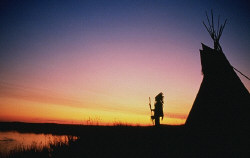Exploring a Proud Heritage
The Prairie Provinces are home to a strong and proud aboriginal heritage, and provide perhaps the best opportunity in North America for travelers to come into contact with First Nations peoples in both a traditional and modern context. There are a number of places and events in both Saskatchewan and Manitoba that provide a glimpse into aboriginal culture, from the time of pre-history to the struggle to maintain identity in the present day.
Traditionally, the Siouan, Blackfoot, Gros Ventre, and Assiniboine peoples were nomadic Plains dwellers, and at a later date the Blackfoot and Plains Cree moved into this region (although Archaeologists and historians debate over when and why). Saskatchewan and Manitoba are also home to the Metis, descendents of both the European voyageurs that made the first push west, and the aboriginal peoples they found when they got there.
|
Tipi Village at Wanuskewin Heritage Park Photos courtesy of Tourism Saskatoon |
Saskatchewan in particular offers a number of venues that offer visitors a glimpse into aboriginal life. Wanuskewin Heritage Park, located just north of Saskatoon, represents over 8000 years of aboriginal presence in what is now known as Saskatchewan. The name Wanuskewin is a Cree word chosen by Elders to describe the history of the place. Loosely translated, Wanuskewin means “seeking peace of mind” or living in harmony.
Amazingly, many of the archeological findings at this site pre-date the Great Pyramids of Egypt. Managed by First Nations peoples, Wanuskewin is a designated National Historic Site. Visitors can immerse themselves in the world-class interpretive center, or head out on the trail to view one of the many archeological sites (19 pre-contact and 2 historic), or just enjoy the view of this traditional wintering ground.
For those looking to involve themselves even more deeply in the experience they can stay in the Tipi Village overlooking the South Saskatchewan River, listen to elders share traditional stories around the campfire at night, and share in the early morning sounds of the Opimahaw Valley. Part of this experience includes a sampling of traditional foods (including the preparation of bannock, a traditional type of bread, over an open fire).
Those wanting to get more information on Wanuskewin Heritage Park can call 306-931-6767, or check out www.wanuskewin.com.
Powwows are held throughout the summer at a number of venues across Saskatchewan and Manitoba. If you have never experienced aboriginal culture before, a Powwow is a spectacle you will never forget. This summer will see one of the largest in North America, the Muskoday First Nation Traditional Powwow, mark the 125th anniversary of the signing of the Plains treaties. Participants will attend from across North America. The Powwow takes place from July 20 to July 22, with the Grand Parades commencing at approximately 1pm and 7pm daily. Muskoday is located just 19 kilometers southeast of the city of Prince Albert, in northern Saskatchewan. For more information call Margaret Bear at 306-763-2753, or check out the events section of www.sasktourism.com.
The Metis have played an integral part in the development of the prairie region. One of the Prairie’s most famous sons was the Metis leader, Louis Riel, who went from being a member of Government to outlaw and center of national debate. Now widely regarded as a hero for his role in protecting the rights of the Metis people, Riel, along with Gabriel Dumont and other Metis leaders, took a definitive role in the Northwest Rebellion of 1885.
|
Warrior in traditional garb at sunset Photos courtesy of Tourism Saskatoon |
The Rebellion was a response of the Metis to the perceived threat presented by the Government of Canada, which had failed to look after the aboriginal peoples of the area. The only battle at which the Government took a decisive victory was at Batoche, although both Riel and Dumont escaped. Visitors to the area can now visit Batoche, a National Historical Site located just northeast of Saskatoon. The bullet holes from the battle can still be observed in many of the buildings. Costumed interpreters lend to the atmosphere of the site, and you almost feel like shots will ring out at any time. Camping is available at the site. For more information on Batoche check out the Parks Canada website.
The annual Back to Batoche Days held on the site (July 27-29, 2001) are a celebration of Metis identity. More information can be found at www.backtobatoche.com, or by calling 306-668-8514. Events include Metis dancers, fiddling and jigging contests, musical entertainment, chuckwagon events, traditional voyageur games, and the launch of the Metis Art Culture Festival.
Regina, to the south of Saskatoon, is home to the Royal Saskatchewan Museum and the extensive First Nations Gallery. Story circles and large dioramas cover over 12,000 years of history, including the signing of treaties and present day life.
Wat’chee Lodge in Manitoba is for those who need some adventure with their culture. Open only in the month of March every year, Lodge owners Michael and Morris Spence offer full-service non-consumptive wilderness encounters. You can experience many traditional aspects of aboriginal culture that still exist by going out on a trapline, taking a dog team for a ride, and building a snowhouse. You can even go check out some polar bears. The brothers can be contacted at 204-675-2114, or via email at watchee@cancam.net. For online information, you can see their site at www.watcheelodge.mb.ca.
There are a large number of other aboriginal events scheduled for the summer; these are listed on the Saskatchewan Tourism site, and for Manitoba.

